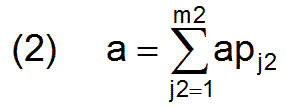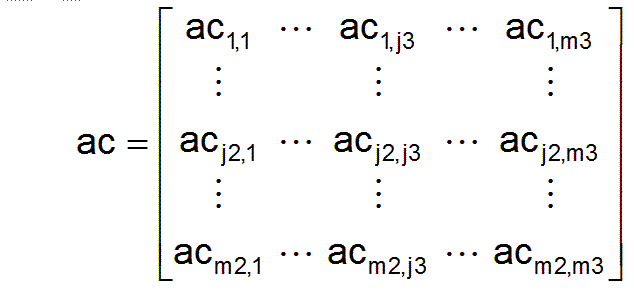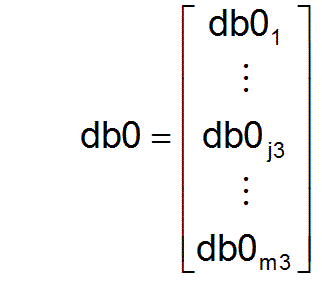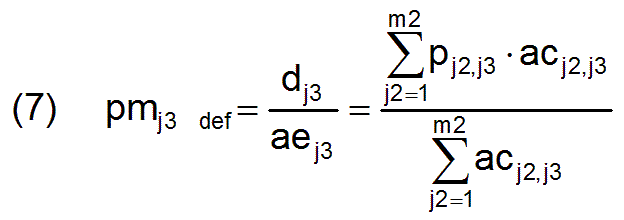3 Mathematical description of an employment structure
Primary parameters:

Each productivity group j2 includes apj2 workers who have the corresponding productivity profile. All these numbers can be summarized in a vector ap, which consists of the m2 components apj2 and which we call the vector of the productivity group sizes.
In fact, every worker has its own productivity profile. By introducing the productivity groups we have not made any significant restriction to the general case because if we set all productivity group sizes equal to one then again an individual productivity profile is given for each worker.



Now another vector shall be introduced as a test criterion for the needs-conformity of the employment structure.

For the sake of simplicity in case of possible economic growth it is assumed that the proportions of the need for profession-specific performances will not change at short notice. This means that every multiple of this vector also results in a needs-based performance structure.
Thus all primary parameters for describing an employment structure have been introduced.
Secondary parameters:
All secondary parameters can be derived from the primary ones. They serve to make it easier to evaluate the later results of an optimization.
For each profession j3 the normalized productivity pnj3 is defined by

The m3 parameters pnj3 are combined to a vector pn, which represents the normalized, profession-independent productivity profile of society.
Using the employment matrix ac and the productivity matrix p, for each profession can be calculated j3 which work performance dj3 is currently achieved in this profession.

The vector d, consisting of the m3 components dj3, results in the structure of the work performance that is currently done due to the current employment matrix ac.
The current numbers aej3 of workers who are employed in the respective profession j3 are calculated from the employment matrix ac by

They are combined in the vector ae
For each profession the mean productivity pmj3 is defined j3 by

Thus pmj3 is the mean productivity of the workers actually employed in this profession, which means it is profession-dependent. (Compare indicative value pm with indicative value pn)
The m3 parameters pmj3 are combined to form a vector pm which represents the mean profession-dependent productivity profile of society. With this vector the "societally necessary working time" for a product is given in the Marxian sense.
The ratio between the mean profession-dependent productivity pmj3 and the normalized (mean profession-independent) productivity pnj3 results in the factor fpj3 for the increase of productivity in the respective profession j3.
(8) fpj3 def= pmj3 /pnj3
As not every profession requires workers from all productivity groups a reasonable employment policy can ensure that the most productive people work within each professional field. The factors fpj3 provide information on the extent to which productivity increases in society are achieved just by employment policy, and thus represent quality criteria of employment policy.The vector db0 is initially given arbitrarily with regard to the level of its components, since at the moment only the relationships of the components to one another are important for the description of a needs-based performance structure. This vector is normalized by introducing a vector dbn for a normalized, needs-based performance structure.

Since the value of the denominator in this formula is constant in relation to the index j3, it is obvious that the vector dbn represents a multiple (or a fraction) of the vector db0 and is therefore also a needs-based performance structure. In addition, the vector dbn corresponds to the performance structure of a needs-based producing society that consists only of one "normal" worker, whose individual productivity profile is pn.
The vector d of the current societal performance structure due to the employment matrix ac does not have to be needs-based. The largest vector it contains which represents a needs-based performance structure is referred to as db. db is then the largest vector of a needs-based performance-oriented structure that is contained in vector d, if for all dbj3 with j3= 1 to m3 the following applies:
(10) dbj3 = fg × a ×dbnj3
where for all applies dbj3 £ dj3 and for at least one j3 applies dbj3 = dj3 .
Hereby the factor fg was introduced as well. It represents the factor of increased overall societal performance due to the employment matrix ac. It is the most important parameter for evaluating the quality of the employment matrix. Therefore it is used as an objective function of an optimization calculation later on.
The factors fbj3 for evaluating the needs-conformity of the work performances can be defined by
(11) fbj3 def= dbj3 / dj3
Accordingly, for each profession they indicate how large the share of needs-based work is in relation to the total work performed in the respective profession. The aim for all fbj3 is to have the value one, because then work is carried out completely needs-based ably.
From these factors the more complex factor fbg can be specified. It provides a quick overview of the needs-conformity of overall societal work performance.

If fbg=1, then in total work is done according to needs. The factor indicates what proportion of workers is involved in the overall societal needs-conform work performance structure db within the possibly non-needs-conform work performance structure d.
Return Go on